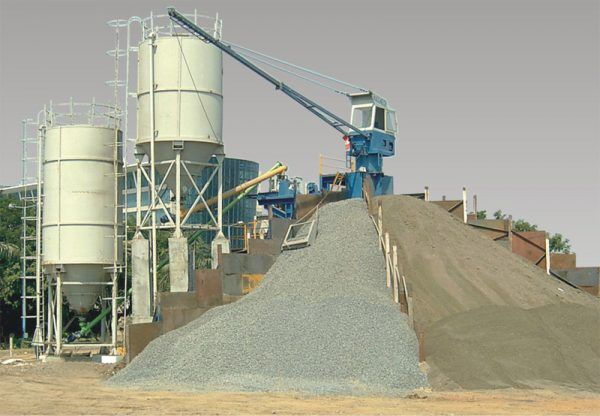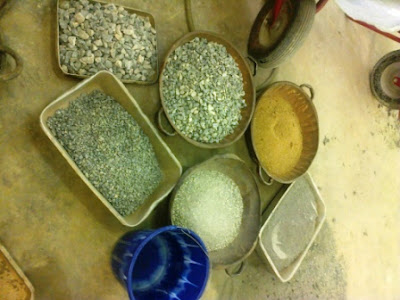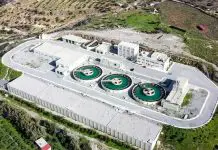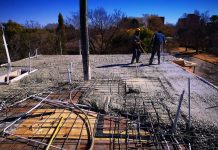Concrete mix design is the process of specifying and proportioning the quantity of concrete ingredients (cement, sand, gravel, and water) required to produce concrete with a specified fresh and hardened properties. Nowadays, engineers should have a deeper understanding of concrete mixes, than just specifying say 1:2:4 concrete mix ratio for their construction works.
Under normal and well-controlled conditions, 1:2:4 mix ratio should yield concrete with 28 days compressive strength greater than 20 N/mm2. However, there are variations in results when batching by weight and when batching by volume. This situation demands that to produce concrete of a specified compressive strength, you have to accurately carry out concrete mix design, which incorporates the tendency of failure during tests.
A little consideration from concrete mix design results will show that the mix ratio for batching by weight, and for batching by volume are not basically the same for obtaining a specified grade of concrete.
The compressive strength of concrete is a very variable quantity. Therefore, when carrying out a concrete mix design, it is important to target a higher average strength so that every part of the structure will meet the specified strength. Statistical standard deviation which is a measure of scatter or dispersion of strength about the mean is normally used to take care of this.
The target strength of concrete (fm) during mix design is given by;
fm = fmin + KSD ————– (1)
Where;
- fm is the mean compressive strength
- fmin is the minimum compressive strength of the concrete. In the Eurocodes, this is called the characteristic strength of the concrete (fck), while in the US, it is called the design strength (fc‘).
- K is the probability factor which is usually taken as 1.64 or 2.33 to express the probability of 1 in 20 and 1 in 100 respectively, for the strength to fall below the minimum strength.
- SD is the standard deviation which is best obtained by considering the previous test results obtained using the same materials, the same procedure, and under the same supervision.
The term KSD is normally referred to as the margin.
The probability of strength values in the range fck ± KSD and below fck – KSD (risk) for normal distribution is shown in Table 1.0 below;
Table 1: The probability of strength values in the range fck ± KSD and below fck – KSD (risk) for normal distribution (Neville and Brooks, 2010)
| Probability factor (k) | Probability of strength values in the range fck ± KSD (%) | Probability of strength values below fck – KSD (%) |
| 1.00 | 68.2 | 15.9 (1 in 6) |
| 1.64 | 90.0 | 5.0 (1 in 20) |
| 1.96 | 95.0 | 2.5 (1 in 40) |
| 2.33 | 98.0 | 1.0 (1 in 100) |
| 3.00 | 99.7 | 0.15 (1 in 700) |
In the Eurocodes and in many other codes, the range of the risk of 1 in 20 is recommended for concrete tests. This means that in 20 concrete cubes, there is a probability of only one cube not meeting the required strength. When statistical data is not available for obtaining the standard deviation, the values in table 2 according to ACI code could be used.
Table 2: Required average compressive strength when data is not available to establish a standard deviation
| Specified Compressive strength f’c (MPa) | Required Average Compressive Strength f’cr (MPa) |
| Less than 21 | f’c + 7.0 |
| 21 to 35 | f’c + 8.5 |
| Over 35 | 1.10f’c + 5 |
The process of carrying out concrete mix design are as follows;
- Test the materials to be used for the concrete mix design. For the aggregates, it is important to obtain the oven-dry relative density, fineness modulus, absorption, and bulk density.
- Establish the target strength of the concrete at 28 days by considering the characteristic strength and the margin which is based on the standard deviation.
- Establish the required water-cement cement ratio for the target strength using relevant tables
- Calculate the water requirement for the desired slump using relevant tables
- Use the calculated water content to calculate the cement content using the water-cement ratio relationship
- Calculate the mass of coarse aggregates using the bulk volume of coarse aggregate per unit volume of concrete
- Calculate the mass of fine aggregates
- Summarise your results
Worked Example
Let us consider the trial mix design for a concrete of minimum specified strength of 25 N/mm2, to be employed in the construction of the floor beams and slab of a building.
Materials Analysis
Coarse aggregate: Crushed granite of nominal maximum size of 20mm
Oven dry relative density = 2.68
Fineness modulus = 2.60
Absorption = 0.4% (saturated surface dry)
Bulk density = 1650 kg/m3
Specific gravity of cement = 3.15
Fine aggregate: Sharp sand from river
Relative density = 2.64
Absorption = 0.60 %
Bulk density = 1600 kg/m3
The target strength can be obtained from the relation below;
fm = fck + KSD
fm = 25 + 8.5 = 33.5 N/mm2
Water-Cement Ratio
The relationship between the water to cement ratio for non-air-entrained concrete (normal concrete) and the 28 days compressive strength is given in Table 3.
Table 3: Relationship between compressive strength and water to cement ratio
| Compressive strength at 28 days (MPa) | Water to cement ratio by mass |
| 45 | 0.38 |
| 40 | 0.42 |
| 35 | 0.47 |
| 30 | 0.54 |
| 25 | 0.61 |
| 20 | 0.69 |
| 15 | 0.79 |
Therefore, Water – Cement ratio for non-air entrained 33.4 N/mm2 concrete = 0.491 (interpolating from Table 3)
Cement and Water Content
Water content is normally estimated from workability requirements, which is guided by the slump. The range of slump required for different types of construction is given in Table 4;
Table 4: Different slumps for different types of construction works
| Concrete Construction | Maximum slump (mm) | Minimum slump (mm) |
| Reinforced foundation walls and footings | 75 | 25 |
| Plain footings, caissons, and substructure walls | 75 | 25 |
| Beams and reinforced walls | 100 | 25 |
| Columns in buildings | 100 | 25 |
| Pavements and slabs | 75 | 25 |
| Mass cocrete | 75 | 25 |
For maximum size of aggregate of 19mm, and a slump of 75mm, the Table 5 gives a water demand of 205 kg/m3
Table 5: Approximate mixing water and target air content requirements for different slumps and nominal maximum sizes of aggregate
| Slump | Water content (kg/m3) for 9.5 mm aggregate size | Water content (kg/m3) for 12.5 mm aggregate size | Water content (kg/m3) for 19 mm aggregate size | Water content (kg/m3) for 25 mm aggregate size | Water content (kg/m3) for 37.5 mm aggregate size | Water content (kg/m3) for 50 mm aggregate size | Water content (kg/m3) for 75 mm aggregate size | Water content (kg/m3) for 150 mm aggregate size |
| 25 – 50 | 207 | 199 | 190 | 179 | 166 | 154 | 130 | 113 |
| 75 – 100 | 228 | 216 | 205 | 193 | 181 | 169 | 145 | 124 |
| 150 -175 | 243 | 228 | 216 | 202 | 190 | 178 | 160 | – |
| Approximate amount of entrapped air (%) | 3 | 2.5 | 2 | 1.5 | 1 | 0.5 | 0.3 | 0.2 |
Therefore cement content;
205/C= 0.491; Therefore the cement content (C) = 205 / 0.491 = 417.515 kg/m3
Mass of Coarse Aggregates
For 19mm aggregate with a fineness modulus of 2.60, the bulk volume of dry rodded coarse aggregate per m3 of concrete is 0.64 (see Table 6).
Table 6: Bulk volume of coarse aggregate per unit volume of concrete
| Nominal maximum size of aggregate (mm) | Bulk volume (2.40 fineness modulus) | Bulk volume (2.60 fineness modulus) | Bulk volume (2.80 fineness modulus) | Bulk volume (3.0 fineness modulus) |
| 9.5 | 0.50 | 0.48 | 0.46 | 0.44 |
| 12.5 | 0.59 | 0.57 | 0.55 | 0.53 |
| 19 | 0.66 | 0.64 | 0.62 | 0.60 |
| 25 | 0.71 | 0.69 | 0.67 | 0.65 |
| 37.5 | 0.75 | 0.73 | 0.71 | 0.69 |
| 50 | 0.78 | 0.76 | 0.74 | 0.72 |
| 75 | 0.82 | 0.80 | 0.78 | 0.76 |
| 150 | 0.87 | 0.85 | 0.83 | 0.81 |
Therefore, mass of coarse aggregate (Mc) per m3 of concrete = 0.64 × 1650 = 1056 kg/m3
Approximate air content = 2%
Mass of fine aggregates
The mass of coarse aggregate can be estimated using the relationship below;
Mass of fine aggregate Mf = γf [1000 – (W – C/γ + Mc/γc + 10A)] ————- (2)
Where;
γf = Specific gravity of fine aggregate (saturated surface dry)
W = Mixing water requirement
C = Cement Content
γ = Specific gravity of cement (take value as 3.15 unless otherwise specified)
Mc = Coarse Aggregate content
γc = Specific gravity of coarse aggregate (saturated surface dry)
A = Air content (%)
Therefore:
Mf = 2.64 [1000 – (205 + (417.515/3.15) + (1056/2.68) + (10 × 2))] = 655.843 kg/m3
Final Volume computations
Water = 205 / (1 × 1000) = 0.205 m3
Cement = 417.515 / (3.15 × 1000) = 0.1325 m3
Air = 2/100 = 0.02
Coarse aggregate = 1056 / (2.68 × 1000) = 0.394 m3
Fine aggregate = 655.843 / (2.64 × 1000) = 0.248 m3
SUMMARY OF TRIAL MIX DESIGN
By weight
Water = 205 kg/m3
Cement = 417.515 kg/m3
Coarse Aggregate = 1056 kg/m3
Fine Aggregate = 655.843 kg/m3
Yield of concrete = 2334.36 kg/m3
Mix ratio by weight (Cement : Fine Aggregate : Coarse Aggregate) = (1:1.57:2.53)
By volume
Water = 0.205 m3
Cement = 0.1325 m3
Coarse Aggregate = 0.394 m3
Fine Aggregate = 0.248 m3
Mix ratio by volume (Cement : Fine Aggregate : Coarse Aggregate) = (1:1.87:2.97)
MIX DESIGN WITHOUT CONSIDERING TEST MARGIN
However, carrying out mix design for 25 N/mm2 grade of concrete without considering the margin, we can obtain the following result using the steps described above;
Water-cement ratio
Water – Cement ratio for non-air entrained 25 N/mm2 concrete = 0.61 (see Table 3 above)
Water and Cement Demand
For maximum size of aggregate of 19mm, and a slump of 75mm, gives a water demand of 205 kg/m3.
Therefore the cement content C = 205/0.61= 336.06 kg/m3
Mass of Coarse Aggregate
For 19mm aggregate with fineness modulus of 2.60, the bulk volume of dry rodded coarse aggregate per m3 of concrete is 0.64. Therefore;
Weight per m3 = 0.64 × 1650 = 1056 kg/m3
Approximate air content = 2%
Mass of Fine Aggregate
Mass of fine aggregate Mf = γf [1000 – (W – C/γ + Mc/γc + 10A)]
Mf = 2.64 [1000- (205 + (336.06/3.15) + (1056/2.68) + 10(2))] = 724.11 kg/m3
Volume computations
Water = 205 / (1 × 1000) = 0.205 m3
Cement = 336.06 / (3.15 × 1000) = 0.1066 m3
Air = 2/100 = 0.02%
Coarse aggregate = 1056 / (2.68 × 1000) = 0.394 m3
Fine aggregate = 724.11 / (2.64 × 1000) = 0.274 m3
Summary of trial mix design without considering the margin
By weight
Water = 205 kg/m3
Cement = 336.06 kg/m3
Coarse Aggregate = 1056 kg/m3
Fine Aggregate = 724.11 kg/m3
Yield of concrete = 2321.17 kg/m3
Mix ratio by weight (Cement:Fine Aggregate:Coarse Aggregate) = (1: 2.15: 3.142)
By volume
Water = 0.205 m3
Cement = 0.1066 m3
Coarse Aggregate = 0.394 m3
Fine Aggregate = 0.274 m3
Mix ratio by volume (Cement:Fine Aggregate:Coarse Aggregate) = (1:2.57:3.696)
Thank you for visiting Structville…….
We love you, and you can like our facebook fan page on;
www.facebook.com/structville












Nice Content Thanks for sharing .. BIM Consulting
BIM Solutions
BIM Solutions in UK
Shop Drawings Preparation in UK
I would really say I have gained a lot visiting this site. Thank you so much for the knowledge.
I would like if there could be an article on grade of concrete for different concrete works e.g Structural members.
For civil engineers, this exhaustive manual on concrete mix design is a priceless resource. Ready Mix Concrete Whitby The comprehensive elucidations of processes and the prioritization of elements that impact mix design determinations contribute to a strong comprehension. Its practical insights establish it as an indispensable resource for engineers operating within the domain.